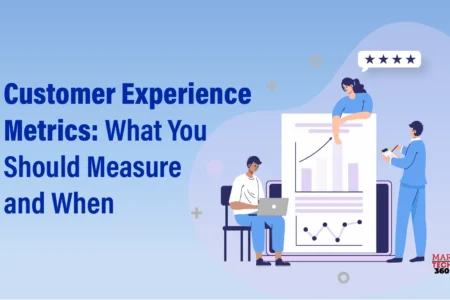Every company wants to create a lasting impression on their customers. But why are brands fixated on this?
HubSpot states that 93% of customers purchase again from companies that offer excellent customer service. Not just that. Nearly three out of five consumers consider excellent customer service essential to foster company loyalty.
This is why customer experience metrics matter, because how else would a company know if they’re doing good or bad? This article discusses customer experience (CX), the must-know metrics, and more.
What Are Customer Experience Metrics?

Bad customer experience has caused 49% of consumers to abandon a brand in the last year. This explains why companies put in more effort toward CX. Businesses that value customer service rather get a 3.5 times increase in income.
Now to gauge and make the company’s offering better, they need to follow up. These key pointers used to understand if a customer had a good or bad experience is what customer experience measurement metrics are about.
Also Read: Digital Experience: 5 Sureshot Ways to Amazing Customer Experiences
What Are the Metrics/KPIs to Track Customer Experience?

Customer Satisfaction Score (CSAT)
User satisfaction is simply measured by the customer satisfaction score. It is applied to products, websites, and services. The question “How pleased were you with [product/website] today?” appears in a normal CSAT survey. On a scale of 1 to 5, 1 represents extreme dissatisfaction and 5 represents extreme satisfaction.
Measure CSAT at relevant points in the customer journey. For example, ask on a purchase confirmation page or during logout.
How to calculate CSAT:
- Add the number of 4 and 5 ratings.
- Divide by the total responses.
- Multiply by 100.
Customer Effort Score (CES)
The customer effort score measures how much effort a customer uses to complete an action. This includes actions like purchasing a product, finding information, or resolving a problem. The scale for CES ratings ranges from 1 to 5 or 7, with 1 being very difficult and 5 or 7 being very easy.
Measure CES by asking, “How easy was it for you to [insert action]?” Do this when customers complete a key action, like after making a purchase, using a service, or talking to customer support.
A high CES means the process was easy. A low score indicates difficulty using the website or unhelpful customer support. Follow up on low CES scores to identify and address friction points
Net Promoter Score (NPS)
Net Promoter Score is a measure of customer loyalty and satisfaction. It asks how likely customers are to recommend your product or service to others on a scale of 0 to 10.
Asking questions like “On a scale of 0–10, how likely are you to recommend us?” will help you get NPS answers. This ought to be carried out following a customer’s reasonable usage of the good or service.
Based on the 0–10 rating, customers are divided into three groups:
- Detractors (0–6) unsatisfied customers
- Passives (7–8) perfectly satisfied
- Promoters (9–10) happiest customers
How to calculate NPS:
- Subtract the percentage of detractors from promoters (passives are not included).
You would receive a score of -100 if all respondents were detractors.
If each person were a promoter, the score would be +100. For instance, a score of +50 would be considered exceptional on the positive end of the spectrum.
Customers can also include written comments explaining why they selected a certain rating in the NPS survey.
Since NPS is not a transaction-based survey, you have discretion over when and how frequently to ask clients for their input on the NPS survey.
Customer Churn and Retention
Customer churn rate measures the percentage of customers who stop using your product. Customer retention is your ability to keep customers over time. Reducing churn and increasing retention are crucial as acquiring new customers is more costly.
High churn and low retention rates signal potential issues in the customer experience. This prompts customers to leave.
How to calculate churn and retention:
- For SaaS and subscriptions: Divide the number of cancellations by the starting number of customers.
- For e-commerce: Use cohort analysis to track repeat purchases in a chosen time frame.
First Response Time (FRT)
First response time calculates the typical time it takes for customer service to address a problem. Depending on the industry, it might be expressed in either days or hours.
How to calculate FRT
- Sum up all initial reaction times.
- Divide by the total number of complaints from customers.
Response times can be shortened by adding more support employees. Optimizing your product to lower support requests is an additional strategy.
You can review support tickets, survey responses, and session recordings. This allows you to pinpoint the areas where users were commonly stuck. Next, enhance the support materials to assist clients in resolving typical problems on their own.
Average Resolution Time (ART)
Average resolution time calculates how long it takes to handle each support request from customers. ART can be expressed in days or hours, just like FRT.
To calculate ART
- Add up the length of every customer conversation.
- Divide by the total number of tickets or interactions with customers.
Higher customer satisfaction is typically the result of a faster ART. This guarantees that customers will like using your service or product.
Customer Lifetime Value (LTV)
Customer lifetime value is the average revenue a customer is expected to bring over time.
How to calculate LTV:
- For SaaS companies: Divide monthly recurring revenue by the number of customer accounts, then divide by user churn rate.
- For e-commerce: Multiply the average order value by purchase frequency and estimated customer lifespan.
LTV is a key revenue metric but also indicates customer loyalty and satisfaction. Happier customers are more likely to buy again or stay subscribed. This increases LTV and business revenue.
How Do You Manage Customer Experience Metrics?
Managing customer experience metrics is crucial for organizations to understand and improve the quality of their customer interactions.
To effectively manage these metrics, it is important to identify the relevant metrics that align with business goals and build a comprehensive dashboard to monitor and analyze them. Applying best practices, such as ensuring data accuracy, setting benchmarks, and connecting metrics to action, is essential.
Organizations should use a variety of metrics to gain a comprehensive understanding of the customer experience and align them with specific customer journeys.
Finally, continuous monitoring and improvement are necessary to track progress and make data-driven decisions that enhance the overall customer experience.
Create an Unshakeably Good Customer Experience
Now the most important part: which metrics should you focus on?
Well, the success of your company doesn’t rely solely on the metrics you choose. Rather, it is based on the improvements or measures you take based on customer feedback.
In the cutthroat ecosystem, nobody will give you a second chance. Studies reveal that 86% of customers leave a brand after two unpleasant experiences. So instead of focusing on selecting the metrics, pay attention to the changes you should make.
Select metrics according to how well they can produce data and whether the outcomes will allow for action or not.

